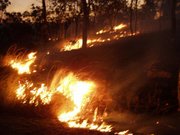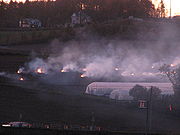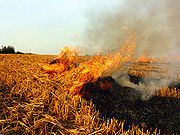- Ecoquema
-
Ecoquema
La quema controlada o prescripta, también conocida como quema para reducir riesgos, es una técnica usada en manejo de forestación, agricultura, restauración de pradera o abatimiento de gases de invernadero. El fuego es una parte natural de la ecología forestal y de pasturas, y los fuegos controlados pueden ser una herramienta para bosques. La reducción de riesgos o el quemado controlado se conduce durante los meses más fríos para reducir el contenido de biomasa y así disminuir la calidad de fuegos calientes peligrosos.[1] Un fuego controlado estimula la germinación de algunas especies deseables de árboles, con renovales del bosque. Algunas semillas, como las de sequoia, permanecen en dormancia hasta que el fuego rompe tal estado.
In industrialized countries, controlled burning is usually overseen by fire control authorities for regulations and permits. The party responsible must delineate the intended time and place. Obtaining a permit may not limit liability if the fire burns out of control.
Contenido
Back burning
Back burning[2] is a way of reducing the amount of flammable material during a bushfire by starting small fires along a man made or natural firebreak in front of a main fire front. It is called back burning because the small fires are designed to 'burn back towards the main fire front'. The basic reason for back burning is so that there is little material that can burn when the main fire reaches the burnt area. The firebreaks that may be used to start a line of fires along could be a river, road or a bulldozed clearing etc.[3]
Forest use
Another consideration is the issue of fire prevention. In Florida, during the drought in 1998, catastrophic wildfires burned numerous homes. But forestry managers noted that the underlying problem was prior cessation of controlled burning, due to complaints by homeowners. Each year additional leaf litter and dropped branches increased the likelihood of a hot and uncontrollable fire.
Controlled burns are sometimes ignited using a tool known as the driptorch, which allows a steady stream of flaming fuel to be directed to the ground as needed. Variations on the driptorch can be used such as the helitorch, which is mounted on a helicopter, or other improvised devices such as mounting a driptorch-like device on the side of a vehicle. A pyrotechnic device known as a fusee can be used for ignition in nearby fuels while a very pistol can be for fuels farther away.
For the burning of slash, waste materials left over from logging, there are several types of controlled burns. Broadcast burning is the burning of scattered slash over a wide area. Pile burning is gathering up the slash into piles before burning. These burning piles may be referred to as bonfires. High temperatures can harm the soil, damaging it physically, chemically or sterilizing it. Broadcast burns tend to have lower temperatures and will not harm the soil as much as pile burning, though steps can be taken to treat the soil after a burn. In lop and scatter burning, slash is left to compact over time, or is compacted with machinery. This produces a lower intensity fire, as long as the slash is not packed too tightly. However, soil may be damaged if machinery is used to compress the slash.
George D. Kessler, professor of forestry, and extension forester at Clemson University notes that controlled burning reduces fuels, may improve wildlife habitat, controls competing vegetation, improves short term forage for grazing, improves accessibility, helps control tree disease, and perpetuates fire dependent species. In old growth Longleaf Pine forest, it helps maintain habitat for endangered Red-cockaded Woodpeckers in their sandhill and flatwoods habitats. However many scientists disagree with such a simplistic approach, and indicate that each forest must be assessed on its own merit.
Agricultural use
First used significantly in the Neolithic Revolution, i.e. about 9-11,000 years ago at the end of the last ice age when hunter gatherers turned to farming. In the developing world, this is often referred to as slash and burn.
In addition to forest management, controlled burning is also used in agriculture. In industrialized nations, it is seen as one component of shifting cultivation, as a part of field preparation for planting. Often called field burning, this technique is used to clear the land of any existing crop residue as well as kill weeds and weed seeds. Field burning is less expensive than most other methods such as herbicides or tillage but because it does produce smoke and other fire related pollutants, its use is not popular in agricultural areas bounded by residential housing.
In the United States, field burning is a legislative and regulatory issue at both the Federal and state levels of government.
Controversy
In Oregon, field burning has been widely used by grass seed farmers as a method for clearing fields for the next round of planting, as well as revitalizing grasses that require fire in order to grow seed again. The Oregon Department of Environmental Quality began requiring a permit for farmers to burn their fields in 1981, but the requirements became stricter in 1988 following a multi-car accident[4] in which smoke from field burning near Albany, Oregon obscured the vision of drivers on Interstate 5, leading to 23-car accident in which seven people died and 37 were injured.[5] This resulted in more scrutiny of field burning and proposals to ban field burning in the state altogether.[6] [7]
Due to extensive research and advocacy from the Western Environmental Law Center, in 2007 the Lane County Board of Commissioners and the Lane County Board of Health decided to formally urge the state’s Environmental Quality Commission (EQC) to order a two-year moratorium of open field burning in the Willamette Valley in order to protect Oregonians from the extreme dangers of smoke inhalation from burning grass seed fields.
Heathland Use
The controlled burning or Swailing of heathland is used in the United Kingdom and other countries as a conservation tool. Often it is used as a tool for creating fire breaks to reduce the risk of dangerous outbreaks but is also an important mechanism for preventing succession to woodier vegetation and plays an important role in the life cycle of heather species.[8]
Greenhouse gas abatement
Controlled burns on Australian savannas can result in an overall reduction of greenhouse gas emissions. One working example is the West Arnhem Fire Management Agreement, started to bring "strategic fire management across 28.000 (Expresión errónea: falta operando para * sq mi) of Western Arnhem Land" to partially offsetting greenhouse gas emissions from a liquefied natural gas plant in Darwin, Australia. Deliberately starting controlled burns early in the dry season results in a mosaic of burnt and unburnt country which reduces the area of stronger, late dry season fires.[9]
See also
- Agroecology
- Bushfire
- Country Fire Service (South Australia)
- Country Fire Authority (Victoria, Australia)
- Fire ecology
- Firebreak
- Fire-stick farming
- Flora of Australia
- New South Wales Rural Fire Service (Australia)
- Shifting cultivation
- Wildfire suppression
References
- ↑ Guidelines for Low Intensity Bushfire Hazard Redustion Burning visto 11 de marzo de 2009
- ↑ What is Hazard Reduction? Retrieved on 10-3-2009
- ↑ Backburning in controlling bushfires to prevent spreading Retrieved on 10-3-2009
- ↑ http://extension.oregonstate.edu/oap/story.php?S_No=80&storyType=oap&page=4
- ↑ http://extension.oregonstate.edu/oap/story.php?S_No=72&storyType=oap&cmd=pf
- ↑ «Eugene Weekly : Coverstory : 7.24.08».
- ↑ http://www.kmtr.com/news/local/story.aspx?content_id=3500afae-7a5f-414c-9d7d-4e191b911cce
- ↑ UK: The Role of Fire in the Ecology of Heathland in Southern Britain (IFFN No. 18 - January 1998)
- ↑ «West Arnhem Land Fire Abatement Project». Tropical Savannas CRC, Savanna Information. Tropical Savannas Cooperative Research Centre. Consultado el 2007-10-08.
Enlaces externos
- BBC News Devon Swailing
- Northern Arizona University
- Tall Timbers Research Center and Land Conservancy
- U.S. National Park Service Prescribed Fire Policy
- Savanna Oak Foundation article on controlled burns
- http://www.epa.gov/oecaagct/tburn.html United States Environmental Protection Agency (EPA) article concerning air pollution consequences of controlled burning
- The Nature Conservancy's Global Fire Initiative
- Strategic fire management West Arnhem Land Fire Abatement Project, Tropical Savannas Cooperative Research Centre
- Fire management and greenhouse gas emissions West Arnhem Land Fire Abatement Project, Tropical Savannas CRC
- Fuel Characteristic Classification System (FCCS) for Wildland Fuels
- European Commission project: FIRE PARADOX - "Learn to live with fire"
Categorías: Silvicultura | Agricultura | Protección contra incendios
Wikimedia foundation. 2010.



